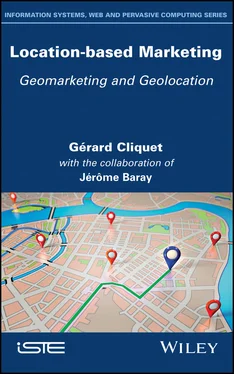1 Cover
2 Preface
3 Introduction
4 1 Spatial Marketing and Geomarketing 1.1. Defining space 1.2. From geomarketing to spatial marketing 1.3. Spatial marketing and geomarketing applications 1.4. Geomarketing, techniques and software 1.5. Conclusion
5 2 The Consumer’s Spatial Behavior 2.1. The main concepts of out-of-store spatial behavior 2.2. Models and theories of spatial consumer behavior outside the store 2.3. The consumer’s in-store spatial behavior 2.4. Conclusion
6 3 The Spatial Marketing Mix 3.1. Spatial marketing and the marketing mix 3.2. Spatial approach to product management 3.3. Spatial approach to the price 3.4. Spatial approach to sales force promotion and management 3.5. Conclusion
7 4 Store Location and Georetailing 4.1. Store location 4.2. Location models and the use of geographic information systems 4.3. Spatial strategies for locating points of sale 4.4. Conclusion
8 5 Spatial Marketing, Geolocation and Mobile Marketing 5.1. From e-commerce to mobile marketing 5.2. Mobile spatial marketing 5.3. Mobile space marketing and space management by organizations 5.4. Conclusion
9 Conclusion
10 References
11 Index
12 End User License Agreement
1 Chapter 2Table 2.1. Variables used to validate MCI-type models (source: Cliquet 1997b)
2 Chapter 3Table 3.1. Generic marketing functions (source: Van Watershoot and Van der Bulte...
3 Chapter 4Table 4.1. The PESTEL model (source: Evans and Richardson 2007 and PESTEL analys...Table 4.2. Weighted evaluation grids for a supermarket site and a convenience st...Table 4.3. Application of the Reilly Law formula to Normandy citiesTable 4.4. Portfolio matrix for multiple locations
1 Chapter 1 Figure 1.1. Theoretical and schematic representation of central place theory (so... Figure 1.2. Map of the addresses of the clients (triangles) of a firm located so...
2 Chapter 2 Figure 2.1. The attraction of the E. Leclerc hypermarkets in Indre-et-Loire (37)... Figure 2.2. Theoretical and actual trading areas. For a color version of this fi... Figure 2.3. Shopping area of stores according to their surface area (source: wit...Figure 2.4. Monitoring a consumer’s in-store shopping trip. The figure shows the...
3 Chapter 3Figure 3.1. Geomarketing and delimitation of geographical areas for sellers (sou...Figure 3.2. Mapping of potential customers (source: with the kind permission of ...Figure 3.3. Travel time to visit potential customers, distinguishing between ind...
4 Chapter 4Figure 4.1. The process of deciding on the location of points of saleFigure 4.2. Trading area and cannibalization of sales and potential by area in N...Figure 4.3. Map of isochrones (source: courtesy of Articque). For a color versio...Figure 4.4. The evolution of the shapes of trading areasFigure 4.5. Definition of trading areas by the proximal area method (source: Gho...Figure 4.6. Outermost points and limits of the trading area (source: according t...Figure 4.7. a) Division of the area into regions. b) Exploded trading area (sour...Figure 4.8. Coverage of a network of points of sale in France (source: Baray 200...Figure 4.9. Studies prior to the opening of a point of saleFigure 4.10. The breaking point or limit pointFigure 4.11. Service locations within a major metro station in Paris (source: co...Figure 4.12. The merger of the Auchan and Mammouth hypermarkets (NB: in these pa...Figure 4.13. Application of the percolation theory to a chain of stores at maxim...Figure 4.14. The meshing of two networks of "soft" discount stores (source: (Cli...
1 Cover
2 Table of Contents
3 Begin Reading
1 v
2 iii
3 iv
4 ix
5 x
6 xi
7 xii
8 xiii
9 xiv
10 xv
11 1
12 2
13 3
14 4
15 5
16 6
17 7
18 8
19 9
20 10
21 11
22 12
23 13
24 14
25 15
26 16
27 17
28 18
29 19
30 20
31 21
32 22
33 23
34 24
35 25
36 26
37 27
38 28
39 29
40 30
41 31
42 32
43 33
44 34
45 35
46 36
47 37
48 38
49 39
50 40
51 41
52 42
53 43
54 44
55 45
56 46
57 47
58 48
59 49
60 50
61 51
62 52
63 53
64 54
65 55
66 56
67 57
68 58
69 59
70 60
71 61
72 62
73 63
74 64
75 65
76 66
77 67
78 68
79 69
80 70
81 71
82 72
83 73
84 74
85 75
86 76
87 77
88 78
89 79
90 80
91 81
92 82
93 83
94 84
95 85
96 86
97 87
98 88
99 89
100 90
101 91
102 92
103 93
104 94
105 95
106 96
107 97
108 98
109 99
110 100
111 101
112 102
113 103
114 104
115 105
116 107
117 108
118 109
119 110
120 111
121 112
122 113
123 114
124 115
125 116
126 117
127 118
128 119
129 120
130 121
131 122
132 123
133 124
134 125
135 126
136 127
137 128
138 129
139 130
140 131
141 132
142 133
143 134
144 135
145 136
146 137
147 138
148 139
149 140
150 141
151 142
152 143
153 144
154 145
155 146
156 147
157 148
158 149
159 150
160 151
161 152
162 153
163 154
164 155
165 156
166 157
167 158
168 159
169 160
170 161
171 163
172 164
173 165
174 166
175 167
176 168
177 169
178 170
179 171
180 172
181 173
182 174
183 175
184 176
185 177
186 178
187 179
188 180
189 181
190 182
191 183
192 184
193 185
194 186
195 187
196 188
197 189
198 190
199 191
200 192
201 193
202 194
203 195
204 196
205 197
206 198
207 199
208 200
209 201
210 202
211 203
212 204
213 205
214 206
215 207
216 208
217 209
218 210
219 211
220 212
221 213
222 214
223 215
224 216
225 217
226 218
227 219
228 220
229 221
230 222
231 223
232 224
233 225
234 226
235 227
236 228
237 229
238 231
239 232
240 233
241 234
242 245
Location-based Marketing
Geomarketing and Geolocation
Gérard Cliquet
with the collaboration of
Jérôme Baray

First published 2020 in Great Britain and the United States by ISTE Ltd and John Wiley & Sons, Inc.
Apart from any fair dealing for the purposes of research or private study, or criticism or review, as permitted under the Copyright, Designs and Patents Act 1988, this publication may only be reproduced, stored or transmitted, in any form or by any means, with the prior permission in writing of the publishers, or in the case of reprographic reproduction in accordance with the terms and licenses issued by the CLA. Enquiries concerning reproduction outside these terms should be sent to the publishers at the undermentioned address:
Читать дальше













